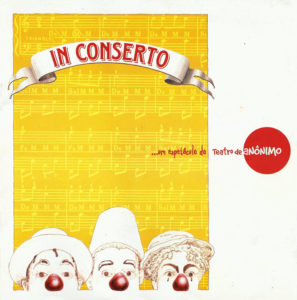![]()
(INFORMAÇÕES DO PROGRAMA)
(Capa)
IN CONSERTO
Um espetáculo do Teatro de Anônimo
(Verso da Capa)
O ofício de ser palhaço.
The craft of being clown.
(Página 01)
Definitivamente, palhaçada para o Teatro de Anônimo é coisa séria. O desejo de entender e aprofundar o conhecimento do universo técnico da nobre arte do palhaço, principalmente no que diz respeito à precisão e ao controle do tempo do riso, fez o grupo atravessar o oceano e buscar na Itália especialização na casa/escola do Nani Colombaioni, representante da quinta geração de uma família que tem suas origens na Commedia Dell’Arte.
O grupo também contou com as inestimáveis colaborações de Ricardo Puccetti (Lume) e Sérgio Machado (Cia. do Público) para a montagem deste trabalho.
In Conserto brinca com a clássica estrutura do trio de “músicos de orquestra”. Um espetáculo modular composto basicamente por três cenas interligadas por uma infinidade de gags tradicionais. E é aí que reside um dos maiores desafios da pesquisa do grupo: reproduzir e/ou recriar este universo já explorado por grandes palhaços de todo o mundo. Baseado na simplicidade, na relação sincera com espectador e no jogo lúdico, o grupo compõe as bases deste brinquedo cênico.
Busquem seus lugares, o espetáculo vai começar!
For Teatro de Anônimo, clowning is definitely serious business. The desire to understand and deepen their acquaintance with the technical universe of the noble art of the clown, principally the concern with precision and timing of the laugh, led the group to cross the ocean and locate in Italy the house/clowning school of Nani Colombaioni, fifth generation member of the family whose origins go back to the Commedia Dell’Arte.
The group also counted on the inestimable collaboration of Ricardo Puccetti (Lume) and Sergio Machado (Cia. do Público) for the mounting of this production.
In Conserto plays with the classic structure of a trio of “orchestra musicians”. It is a popular performance composed basically of three scenes interlinked by a wide variety of traditional gags. And it is a here that lies one of the major challenges in the group’s research: how to reproduce and/or recreate this universe, already explored by great clowns the world over. The group composes the basis for this scenic game by focusing on simplicity, the sincere relationship with the audience and the notion of ingenuous play.
So take your seats, the show is about to begin!
(Página 02)
O Espetáculo
Trio de palhaços chega ao local para dar um concerto público, mas muitas trapalhadas acontecem até que consigam executar suas peças.
No programa, a Ópera Desastrada, pelo alto barítono Seu Flor e seu molto lento discípulo Cuti-Cuti.
Em seguida, é a vez de Buscapé executar sua peça musical, até que se depara com uma fatalidade do destino: seu estimado apito mirim ultrapassa a barreira da vida e vira estrela. Em seu périplo fúnebre, Buscapé leva o público às lágrimas de tanto rir.
No Gran Finale, os três atrapalhados palhaços executam, agora com instrumentos de verdade, acordeon, cavaquinho e trumpete, seu concerto. Mas, porém, contudo, todavia, entretanto… até que isso ocorra muitas outras tentativas e erros se sucedem.
The Performance
A trio of clowns arrives in order to give a concert but a lot of mishaps take place until they manage to play their pieces.
The programme begins with the Doomed Opera by the alto baritone Seu Flor and his molto piano disciple Cuti-Cuti.
Next it is Buscapé’s turn to execute her musical piece, which comes along nicely until she encounters fatalistic destiny: her esteemed whistle transcends life’s frontier to become a celestial body. In its funeral procession, Buscapé makes the audience cry with laughter.
In the Gran Finale, finally, the three misfortunate clowns give their concert, this time with real instruments, accordion, mini-guitar and trumpet. But, nevertheless, in spite of, and until this happens there are numerous false starts, mistakes and misunderstandings to overcome.
(Página 03 – Foto de Cena)
O Ator / Palhaço
“Ser ou não ser palhaço, eis a questão.”
É possível que alguns críticos e observadores mais atentos digam que há uma avalanche de espetáculos de Clown no cenário teatral brasileiro e é bem possível que eles estejam certos. É necessário, porém, tentar fazer uma distinção fundamental entre “espetáculo de palhaço” e “palhaços fazendo um espetáculo”, entre encenar a palhaçada e ser de fato o palhaço, a criatura que tem no riso coletivo o seu ofício, sua obsessão e que alimenta nos olhos do espectador sua utopia de um mundo subvertido, diferente e feliz.
Olhar nos olhos do espectador, resistir à tentação de desviar, não desistir, quebrar a expectativa, estabelecer a sintonia e brincar com o público é uma conquista que requer tempo, treinamento e muito exercício de humildade e generosidade. Essa é a regra base do jogo, abrir o coração. O palhaço é um ator desmontado, desconstruído.
The Actor / Clown
“To be or not to be – a clown – that is the question.”
Possibly some more attentive critics would say that there has been an avalanche of Clown performances in the Brazilian theatre of late and it is quite probable that they are right. It is necessary therefore to try to make a fundamental distinction between “ a clown performance” and “clowns doing a performance”, between staging clowning and to be de-facto a clown, that creature for whom collective laughter is a craft, an obsession, and who nourishes the spectators eyes with his utopia of a subverted world, different and joyous.
To look into the audience’s eyes, resisting the temptation to turn away, not to give up until one feels totally comfortable stretching out for a long as possible the time of the scenic action, breaking expectations, establishing synchronicity and playing with the audience is a conquest that requires time, training and the exercising of humility and generosity. This is the basic rule of the game, open the heart. The clown is an actor “taken apart”, deconstructed.
(Página 06 – Foto)
O Riso Como Dramaturgia em Si
In Conserto não tem história para contar, é um jogo em que um trio de paspalhos vai à cena para tocar. Não é faz-de-conta, não é “interpretação”. Eles sabem que estão diante de um público, naquele teatro ou naquela praça, que aquele senhor careca está ali, que a senhora com seu vestido vermelho trouxe a sobrinha bonita, etc. nada é ignorado.
A partir daí se dará um jogo de intimidade e cumplicidade com a plateia a partir das situações mais ingênuas e imbecis, ações físicas, viagens da alma compartilhada a cada milímetro com o público, onde o riso aberto e a participação popular se tornam inevitáveis.
O riso e a festa coletiva são o objetivo do nosso trabalho, buscamos a partir do domínio do tempo/ritmo, subverter por alguns momentos a lógica do tempo cotidiano, arrogante e pretensioso do homem. O espectador ri porque se sente igual ou superior àquelas criaturas idiotas ou porque, por ser membro de uma sociedade brutal, egoísta e individualizada, diante de tanta sinceridade e humanidade, não compreende e ri. Às vezes, até chora.
Laughter as Dramaturgy in Itself
In Conserto does not have a story to tell, it a game in which a trio of clowns go on stage to play music. It isn’t pretending, it isn’t “representing”. They know they are in front of an audience, in that precise theatre, or that exact square, that the bald man is right over there, that the woman in the red dress has brought her beautiful niece etc. Nothing is ignored.
From then on, from the most ingenuous and stupid situations, physical actions, voyages of the soul shared inch by inch with the audience, there develops a game of intimacy and complicity with the public in a way that in the end, unabashed laughter and participation become inevitable.
Laughter and the collective celebration is the objective of our work, we search for this by the domination of timing and rhythm, subverting in some moments the logic of the everyday, arrogant and pretentious timing of man. The spectators laughs because they feel equal or even superior to those idiotic creatures, because as members of a brutal, egotistic and individualistic society confronted with such sincerity and humanity, they don’t understand…and laugh. Sometimes even cry.
(Página 07 – Fotos)
(Página 08 )
Clownaria Clássica
Nani Colombaioni nos mostrou durante o período em que convivemos com ele e sua família em Roma, janeiro de 98, a importância da verdade no jogo. Dizia ele: “Quem vê palhaço, não pode ver que aquilo está ensaiado. Tem que ter muita técnica para fazer o público acreditar que o seu chapéu caiu sem querer, ele não pode perceber o truque”…Cochichando no nosso ouvido disse: “O público tem que acreditar que aquilo está acontecendo pela primeira vez.”
E foi a partir daí, aprendendo a fazer o público acreditar nos tropeções, nas cascatas (escorregões e quedas), buscando o tempo justo, a fidelidade ao ritmo de cada jogo, a precisão das ações físicas repetidas várias vezes sob a severa batuta de Nani, que passamos, de fato, a compreender que a “Clownaria” exige uma técnica rigorosa, trabalha com um universo de jogo com regras muito definidas que o velho mestre gostava de chamar de “La bela scuola”.
É esse o jogo proposto pelo espetáculo, não tem nenhuma novidade, é pura “Clownaria Clássica”. Dispensa recursos tecnológicos, bastam os palhaços, o público e uma luz para iluminar os olhos dos atores e espectadores, o resto são gags, tropeções e muita paspalhice, pequenas bobagens que fazem um grande jogo de alegria coletiva.
Classic Clowning
Nani Colombaioni showed, during the time we lived with him and his family in Rome, January of 1998, the importance of realism in the game. He used to say: “Whoever watches the clown cannot see something rehearsed. You need to have a lot of technique in order to make the public believe that your hat fell off by accident. They mustn’t perceive the trick”…Whispering in our ear he could say : “The public must believe that what they see is happening for the first time”.
It was from then on, leaning to make the audience believe in the stumblings, the slips and falls, looking for the correct timing, the fidelity to the rhythm of each game, the precision of the physical actions repeated again and again under Nani’s severe conductor’s baton, that we actually came to comprehend that “Clowning” was about a rigorous technique, a universe of play with very defined rules that the old master liked to call: “La bella scuola” ( “The beautiful school”).
It is the game that is proposed in the performance. There is no novelty, it is pure “Classic Clowning”. Dispensing with technological resources, making do with just the clowns, the audience and enough light to illuminate the eyes of the actors and spectators, the rest being gags, falls, lots of fooling around and small stupidities that all add up to a great game of collective joy.
(Página 09)
Roteiro e Direção
A primeira cena é do repertório clássico da família Colombaioni nos foi dada de presente por Nani. A segunda cena é criação da própria Shirley sob a direção de Ricardo Puccetti, do LUME. A terceira faz parte do nosso repertório há seis anos e foi minuciosamente trabalhada e aperfeiçoada através do “Sistema di Lavoro” de Nani.
A responsabilidade de reunir essas três cenas distintas em um único espetáculo foi confiada ao ator cômico e igualmente palhaço Sérgio Machado (Cia. do Público). Com um olhar cirúrgico de quem domina amplamente as questões do tempo/ritmo e da lógica da construção do riso em seu próprio corpo, Sérgio Machado deu o toque final a esse espetáculo encenado, criado e dirigido por palhaços, parceiros e amigos. O jogo vai começar!
Script and Direction
The first scene comes from the classic repertoire of the Colombaioni Family and was given to us a present by Nani. The second scene was created by Shirley under the direction of Ricardo Puccetti from LUME. The third has been part of our repertoire for six years now and was microscopicly worked on and perfected by Nani and his “Sistema di Lavoro (“System of Work”).
The responsibility to unite these three distinct scenes into one show was given to the comic actor and likewise clown, Sérgio Machado (of the group Cia. do Público). With a surgeon’s eye and ample domination of the questions of timing/rhythm and the logic behind the construction of the laugh in his very body, Sérgio Machado put the final touches to this performance, mounted, created and directed by clowns, partners and friends. The show is about to begin!
Um Diretor…
No início eram trevas, depois…vieram os dinossauros. A parte de Jesus eu vou pular, pois é um pouco polêmica …enfim o homem, que antes era macaco, foi evoluindo…evoluindo…evoluindo…, até virar palhaço. E aí quando eu cheguei, durante o descanso do criador, tudo já era espetáculo. Três palhaços e três números. Entrei então no jogo e na brincadeira. Tornei-me um espectador com privilégios de diretor. Trabalhamos a partir de ações simples, o início, o meio e o fim e, principalmente, os tempos que existem entre eles – para um palhaço, nem sempre ultrapassar o meio, significa estar mais perto do final. Mantivemos cada elemento do riso que pudesse ser compartilhado com outras pessoas. Assim nasceu In Conserto! Um espetáculo que mostra a técnica do ator em relação direta com a plateia, sem perder no entanto, a espontaneidade do palhaço. É pura poesia e diversão.
A Director…
In the beginning there was darkness…then came the dinosaurs. I’ll skip the part about Jesus, since its a bit controversial…Anyway, finally, man, who used to be a monkey kept on evolving…and evolving…and evolving…until he became a clown. And when I arrived, while the creator was having a bit of a rest, it was already a performance. Three clowns and three numbers. So I joined in the fun and games. I became a spectator with the privileges of a director. We worked on simple actions, the beginning, middle and end, and mainly the time that exists between each of these – for a clown, getting past the middle does not necessarily mean being closer to the end. We kept every element of the laugh that could be shared with others. That was how In Conserto was born! A performance that shows the actor’s technique in direct relationship with the audience, without losing, at the same time, the spontaneity of the Clown. It’s pure poetry and diversion.
Sérgio Machado
(Verso da Última Capa)
![]()
Credits and Specifications
Direção Final / Final Direction: Sérgio Machado
Criação dos Números / Creation of Acts: Nani Colombaioni, Ricardo Puccetti e Teatro de Anônimo
Iluminação / Lighting: Djalma Amaral
Cenário / Scenery: Hélcio Pugliese e Abel Saavedra
Figurino / Costumes: Fernanda Sabino e Teatro de Anônimo
Arranjo / Arrangement: Jeronimo Sérgio
Supervisão Vocal / Vocal Supervision: Luanda Siqueira
Direção de Produção / Direction of Production: João Carlos Artigos
Produção Executiva / Executive Production: Flávia Bertoni, Maria Alice Silvério e Maria Cristina Azevedo
Fotos / Photos: Celso Pereira, Karla Mourão e Marcelus Pequeno
Texto / Text: Márcio Libar
Versão para Inglês / English Translation: Naomi Silman e Júlio Adrião
Design Gráfico / Graphic Design: Studio Ato Gráfico / Marcos Corrêa e Hannah
Criação e Concepção / Creation and Conception: Teatro de Anônimo
![]()
Cast
João Carlos Artigos: Seu Flor / Acordeon
Márcio Libar: Cuti Cuti, Cavaquinho
Shirley Britto: Buscapé / Trumpete
www.teatrodeanonimo.art.br
anonimo@domain.com.br
João Carlos Artigos e/ou Flávia Berton
TeleFax: 55 21 557 6505
Celular: 9969 6326
(Última Capa)
Apoio
(Logos) Museu do Telephone, Telemar, Degraus, Cristina Bustamante, Gambino
Apoio Espiritual: Santo Expedito
Apoio Moral: Mamãe
Apoio Psicológico: Jung
Apoio Físico: Escadas, bengalas e paredes
Apoio Financeiro: Hahaha…essa é boa mesmo!
Realização
(Logo) Teatro de Anônimo





